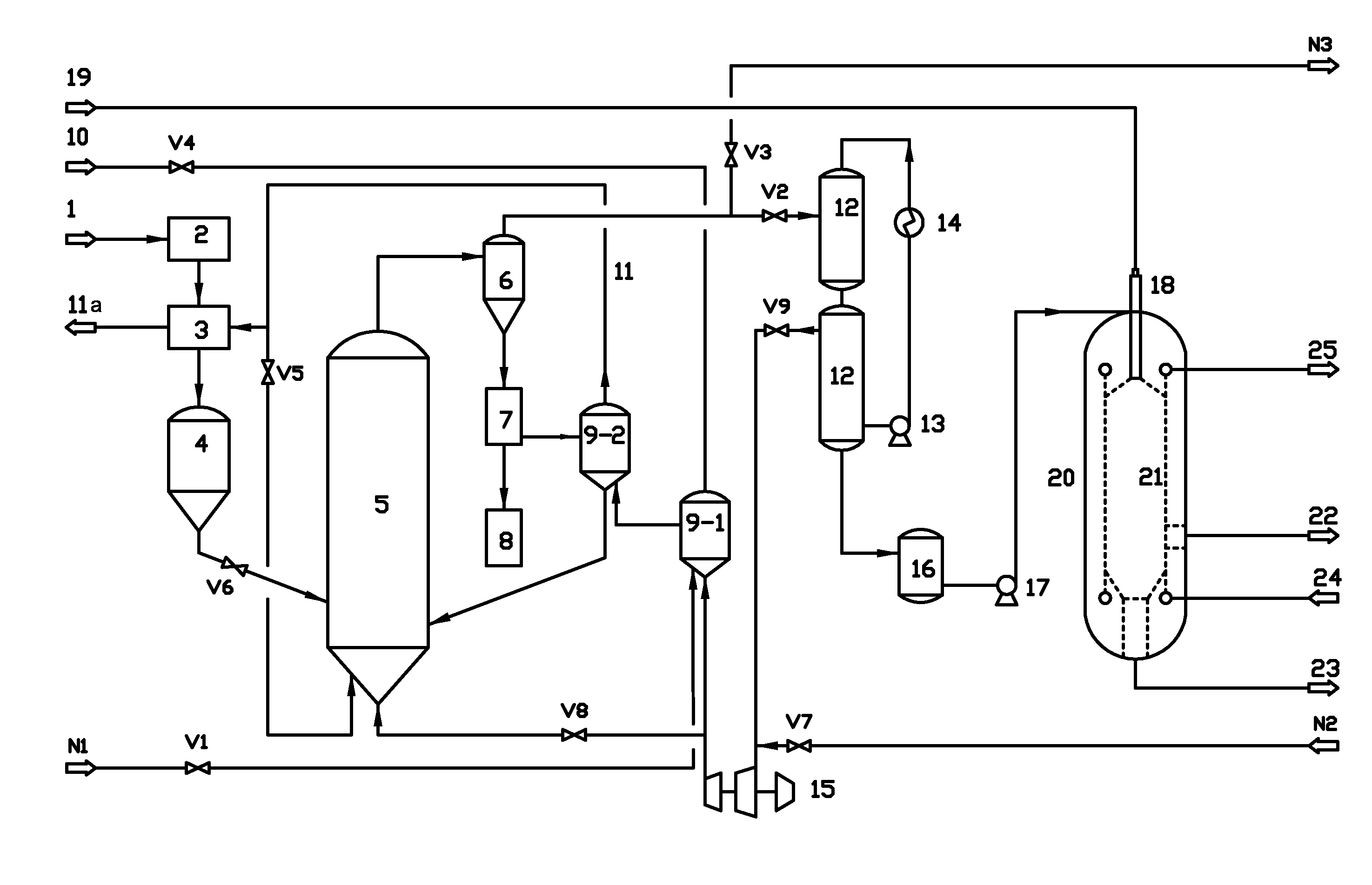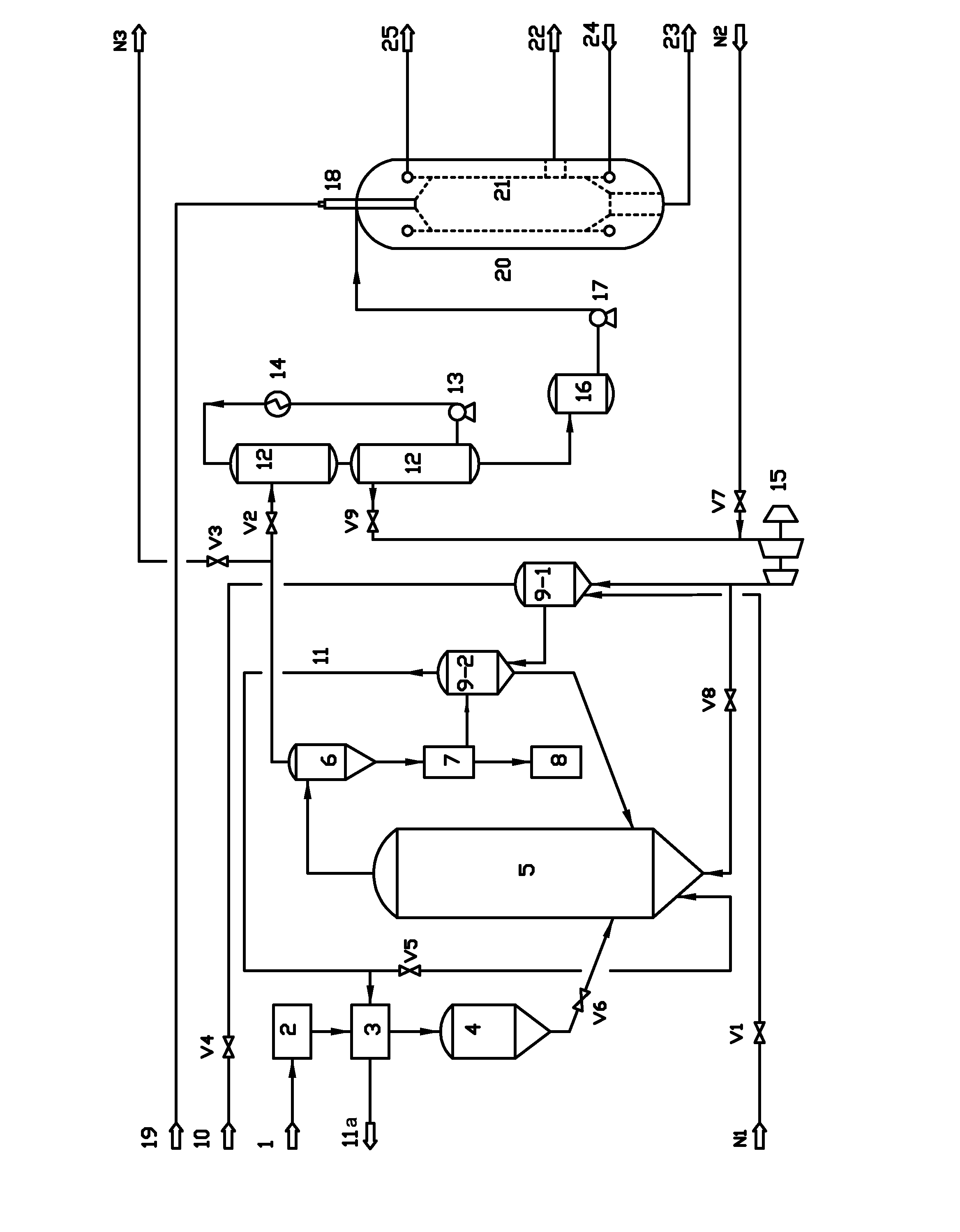Method and system for producing synthesis gas
a technology of synthesis gas and gas, applied in the direction of combustible gas production, combustible gas purification/modification, energy input, etc., can solve the problems of low heating value of synthesis gas at the outlet, low heat exchange efficiency, and large amount of synthesis gas, and achieve low cost and high efficiency.
- Summary
- Abstract
- Description
- Claims
- Application Information
AI Technical Summary
Benefits of technology
Problems solved by technology
Method used
Image
Examples
example 1
[0065]Take wood as a raw material of biomass. The elemental composition and characteristic data of the dried wood are listed in Table 1.
TABLE 1Elemental composition and characteristic data of the dried woodItemsSymbolUnitValueCarbonCar% (Kg / Kg)39.43HydrogenHar% (Kg / Kg)5.21OxygenOar% (Kg / Kg)38.36NitrogenNar% (Kg / Kg)0.15SulfurSar% (Kg / Kg)0.21ChlorineClar% (Kg / Kg)0.00AshAar% (Kg / Kg)5.00MoistureMar% (Kg / Kg)11.64Ash fusion pointFT° C.1436Low heat valueLHVMJ / Kg14.75
[0066]The main operating conditions are set as follows:[0067]1) the grain diameter of the material at the outlet of the crushing system 2 is 6 mm;[0068]2) the water content of the material at the outlet of the drying system 3 is 15 wt. %;[0069]3) the pressure of the pyrolysis bed 5 is normal pressure and the temperature is controlled at 400° C.;[0070]4) gas phase residence time of the pyrolysis bed 5 is 5 s; and[0071]5) the pressure of the gasification furnace 20 is controlled to be 4.0 MPa (A) and the temperature is controlled...
example 2
[0076]Take wood in Example 1 as a raw material of biomass (Table 1).
[0077]The main operating conditions are set as follows:[0078]1) the grain diameter of the material at the outlet of the crushing system 2 is 5 mm;[0079]2) the water content of the material at the outlet of the drying system 3 is 20 wt. %;[0080]3) the pressure of the pyrolysis bed 5 is normal pressure and the temperature is controlled at 500° C.;[0081]4) gas phase residence time of the pyrolysis bed 5 is 3 s; and[0082]5) the pressure of the gasification furnace 20 is controlled to be 4.0 MPa (A) and the temperature is controlled at 1400° C.
[0083]According to the set conditions above, the main data and performance parameter of the system in the implementation process of the invention are explained in detail with the attached drawing:[0084]1) biological fuel quality yield of the biomass raw material fed to the pyrolysis bed 5 is 60%;[0085]2) dry basis content of CO and H2 in the synthesis gas output by the pipeline 22 ...
example 3
[0087]Take wood in Example 1 as a raw material of biomass (Table 1).
[0088]The main operating conditions are set as follows:[0089]1) the grain diameter of the material at the outlet of the crushing system 2 is 4 mm;[0090]2) the water content of the material at the outlet of the drying system 3 is 10 wt. %;[0091]3) the pressure of the pyrolysis bed 5 is normal pressure and the temperature is controlled at 600° C.;[0092]4) gas phase residence time of the pyrolysis bed 5 is 2 s; and[0093]5) the pressure of the gasification furnace 20 is controlled to be 4.0 MPa (A) and the temperature is controlled at 1400° C.
[0094]According to the set conditions above, the main data and performance parameter of the system in the implementation process of the invention are explained in detail with the attached drawing:[0095]1) biological fuel quality yield of the biomass raw material fed to the pyrolysis bed 5 is 65%;[0096]2) dry basis content of CO and H2 in the synthesis gas output by the pipeline 22 ...
PUM
| Property | Measurement | Unit |
|---|---|---|
| temperature | aaaaa | aaaaa |
| particle sizes | aaaaa | aaaaa |
| temperature | aaaaa | aaaaa |
Abstract
Description
Claims
Application Information
 Login to View More
Login to View More - R&D
- Intellectual Property
- Life Sciences
- Materials
- Tech Scout
- Unparalleled Data Quality
- Higher Quality Content
- 60% Fewer Hallucinations
Browse by: Latest US Patents, China's latest patents, Technical Efficacy Thesaurus, Application Domain, Technology Topic, Popular Technical Reports.
© 2025 PatSnap. All rights reserved.Legal|Privacy policy|Modern Slavery Act Transparency Statement|Sitemap|About US| Contact US: help@patsnap.com


